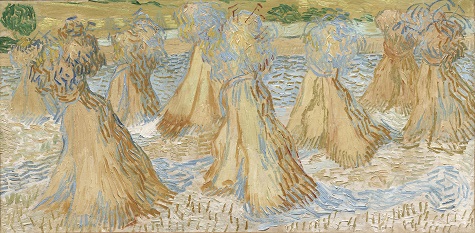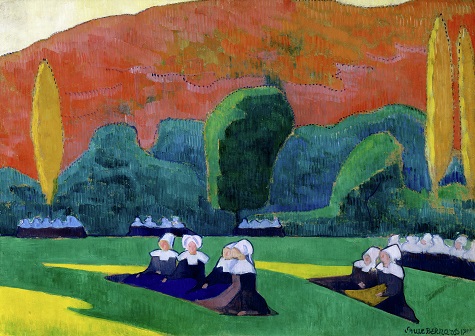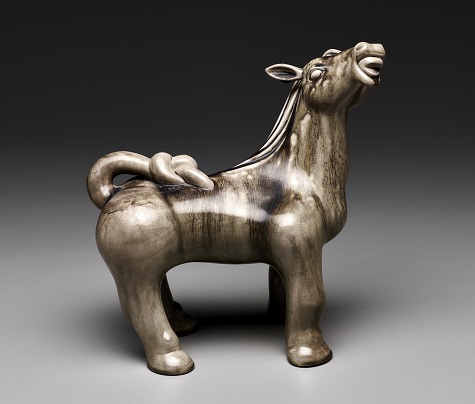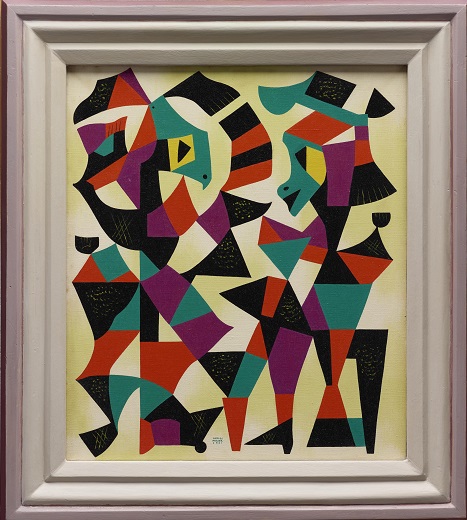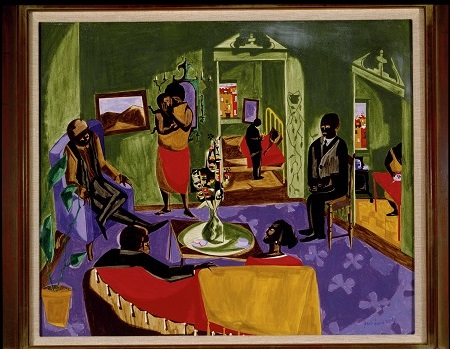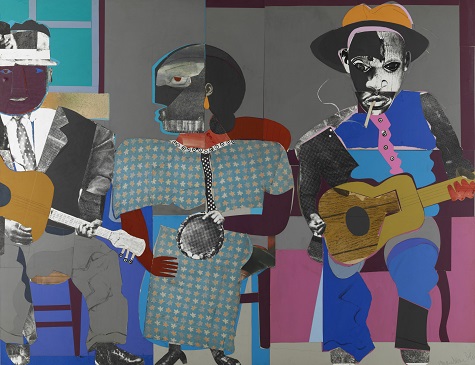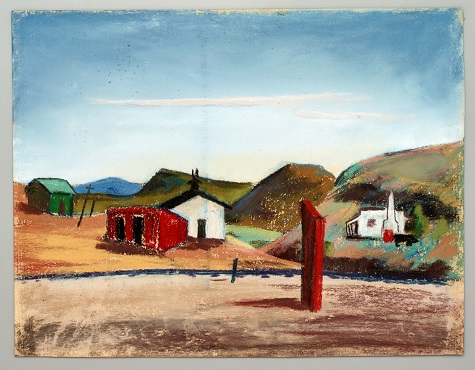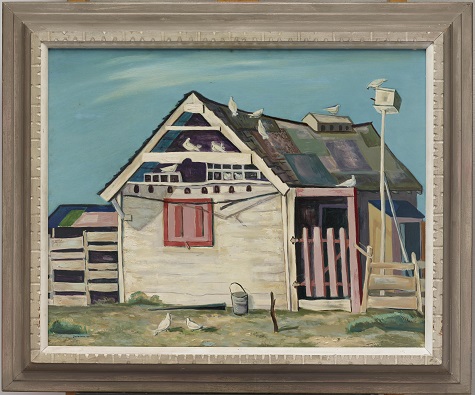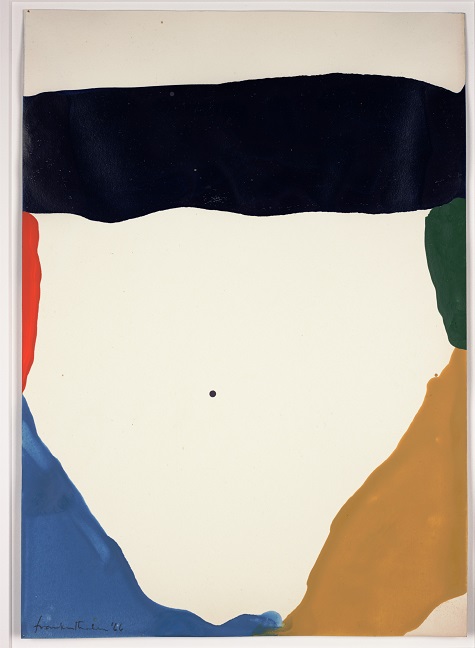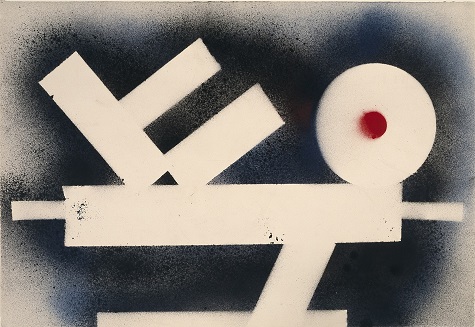Did you know January 14 is national Dress Up Your Pet Day? Yeah, we didn’t either. Here at the DMA, we not only love our art, but we also love our animals. We couldn’t resist combining some of our favorite works from our permanent collection with some of our favorite pet pals.
We promise that no animals were harmed in creating these photos. Well, maybe just a few pet egos.
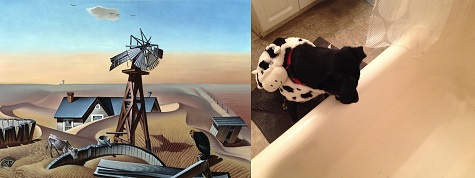
DMA Staffer: Danielle Schulz, Teaching Specialist
DMA Pet: Ruby, Lab/Collie mix, age 2
Portrait Inspiration: Alexandre Hogue, Drouth Stricken Area, 1934
I wanted to transport Hogue’s characteristic desert-like scene to my tiny apartment, and lucky for me, I was able to find an eager canine ready to put on a cow costume and thirstily explore a bathtub water tank. This work will soon be on view in the upcoming exhibition Alexandre Hogue: The Erosion Series.
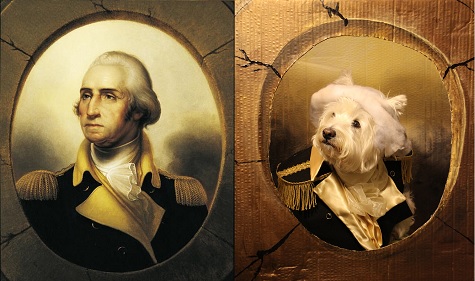
DMA Staffer: Amanda Blake, Head of Family, Access, and School Experiences
DMA Pet: George Costanza, West Highland White Terrier, age 7
Portrait Inspiration: Rembrandt Peale, George Washington, c. 1850
Like George Washington, George the Westie is courageous and fearless in the face of danger. He is an alpha dog and has been known to keep much larger dogs in line. Plus, I thought that he would look very handsome in a colonial costume.
(Editor’s note: This is George as himself, no airbrushing or Photoshop for him!)
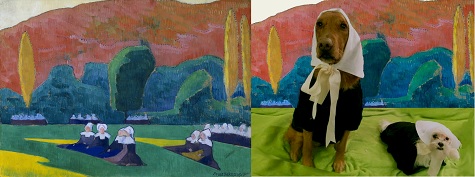
DMA Staffer: Andrea Severin Goins, Interpretation Specialist
DMA Pets: (from left to right) Shelby, Golden Retriever, age 6, and Artemisia Gentileschi (“Artie”), Malshi/Maltese/Shih Tzu Hybrid, age 4
Portrait Inspiration: Emile Bernard, Breton Women Attending a Pardon, 1892
Artemisia and Shelby love the outdoors; in particular Artie likes to sunbathe and Shelby loves to people watch while enjoying a nice breeze. They like Bernard’s painting because it looks like a place they would like to visit: a lush field, rich with bright hues, and filled with nice ladies who might pet them.
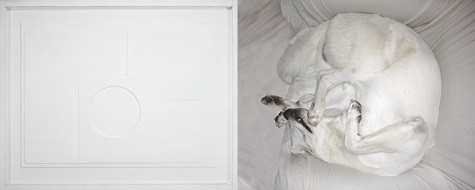
DMA Staffer: Chad Redmon, Assistant Photographer
DMA Pet: Ajax, White Alsatian, age 3
Portrait Inspiration: Ben Nicholson, 1936 (white relief), 1936
I’ve admired Ben Nicholson’s White Relief long before I was even an employee here at the DMA. I respond to minimal and reductive aesthetic strategies and this one is a stellar example of such. When I found Ajax asleep in my chair, viewed from that overhead perspective, my mind went immediately to the work by Nicholson. Quick iPhone shot and some simple Photoshopping and there it is.

DMA Staffer: Doug Landrith, Gallery Attendant
DMA Pets: (from left to right) Ella, Leopard Tortoise, age 5; Gurdy, Sulcata Tortoise, age 6; Tanaka, Red Foot Tortoise, age 7
Portrait Inspiration: Frederic Church, The Icebergs, 1861
Tortoises look like monumental rock formations anyway, so The Icebergs seemed like a perfect fit. It was honestly more entertaining having them roam around the yard with their ice hats on running into things.
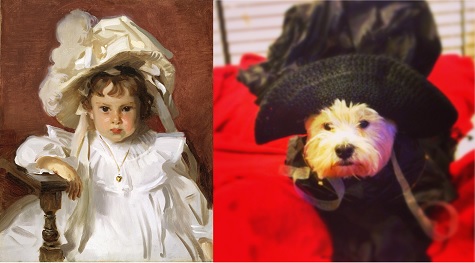
DMA Staffer: Kimberly Daniell, Manager of Communications and Public Affairs
DMA Pet: Chloe (she is actually my roommate’s dog. I dog-napped her for the photo shoot), West Highland Terrier, age 8
Portrait Inspiration: John Singer Sargent, Dorothy, 1900
Dorothy is one of my favorite works in the collection. Chloe is sassy and has an attitude and I envision Dorothy was the same way. A white ensemble did not show up well on her fur, so she went for a more brooding Dorothy look.
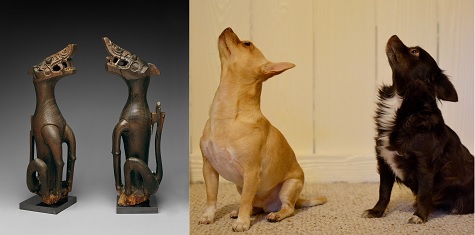
DMA Staffer: Jessica Fuentes, Gallery Coordinator for the Center for Creative Connections
DMA Pets: (from left to right) Fidel, Short Haired Chihuahua, age 3, and Nene, Long Haired Chihuahua, age 4.5
Portrait Inspiration: Pair of mythical animals (asos), 19th century
It’s only within the last six months or so that I have become familiar with the pair of mythical animals, as it is a piece that C3 focuses on for our Indonesian Gallery Pop-Up Art Spot. I love how these creatures are clearly dog-like and are a protective symbol. When thinking about which work of art I would pick for my dogs to re-enact, I immediately thought of this one. My pair of Chihuahuas may not be as graceful or intimidating as these mythical animals, but they are a source of comfort to me and my daughter. Clearly they do not realize how small they are, because they jump up, bark and chase after any foreign sound they hear. (In order to get them to sit up and pose like this, I had to enlist the help of my daughter… she is out of the frame, standing on a chair, holding a treat and telling them to “sit” and “stay.”)
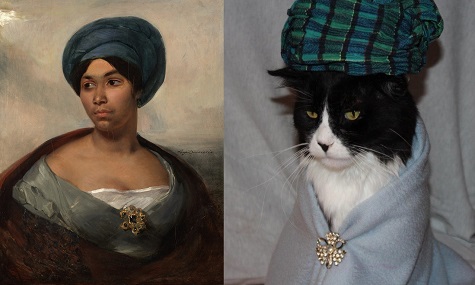
DMA Staffer: Queta Moore Watson, Senior Editor
DMA Pet: Ollie, Tuxedo Cat (Domestic Medium Hair), age 5
Portrait Inspiration: Eugène Delacroix, Portrait of a Woman in a Blue Turban, c. 1827
I chose this work because my cat Ollie shares with Eugène Delacroix’s subject a pensive expression and soulful eyes. Delacroix had a penchant for representing exotic women from foreign lands. While Ollie is a Domestic Medium Hair rather than an exotic breed, he does mirror the subject’s enigmatic gaze. Is he pondering the future? Remembering the past? Perhaps he is thinking, “I’m a cat. Why am I wearing a turban?”
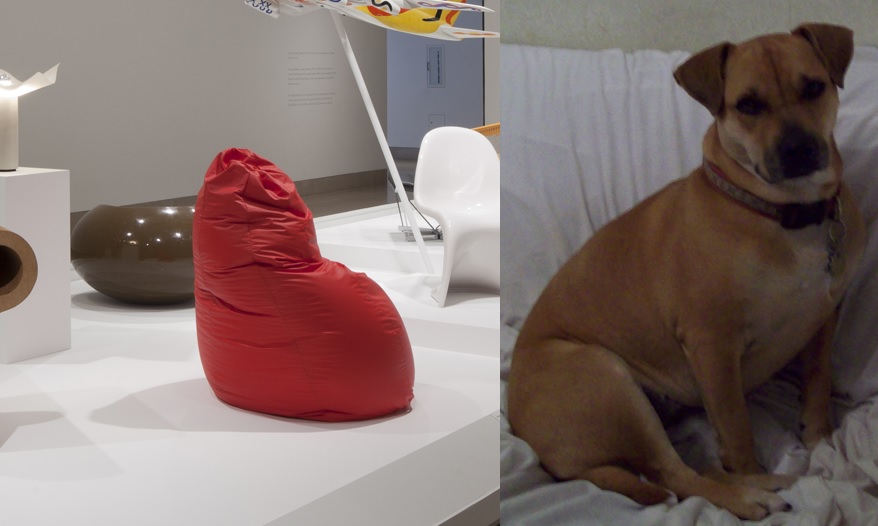
DMA Staffer: Reagan Duplisea, Associate Registrar, Exhibitions
DMA Pet: Mosey, Florida Brown Dog, age 9
Portrait Inspiration: Sacco chair, Piero Gatti, Cesare Paolini, Franco Teodoro, Zanotta, designed 1968-1969
A dear friend of mine once called Mosey “a little dumpling,” and even though she is really all muscle, the nickname stuck. She always sits sideways, directly on her rear end, and her “dumpling” shape reminds me of the red beanbag chair currently on view in the exhibition Form/Unformed: Design from 1960 to the Present.
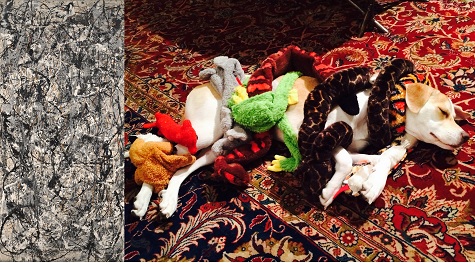
DMA Staffer: Catherine Cody, Special Events and Volunteer Relations Manager
DMA Pet: Jane, Mutt, age 1
Portrait Inspiration: Jackson Pollock, Cathedral, 1947
Pollock is one of my favorite painters, particularly in the way he suggests “energy made visible”. My dog Jane is the definition of visible energy, and her life often looks like a Pollock painting. She ate the string I bought to design our interpretation of Cathedral, so we improvised with some of her toys. I think Pollock would approve.
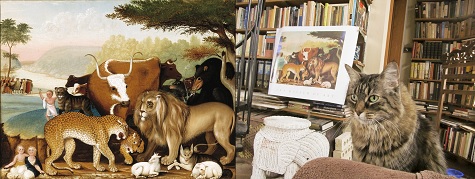
DMA Staffer: Anne Bromberg, The Cecil and Ida Green Curator of Ancient and Asian Art
DMA Pet: Miss Suzl, Maine Coon cat, age 4
Portrait Inspiration: Edward Hicks, The Peaceable Kingdom, c. 1846-1847
I thought Miss Suzl would be interested in the painting and probably recognize her big relations in it. I envision Miss Suzl’s comments on this painting are either “SOMETIMES I’m peaceable, but don’t count on it” or “wanting to lie down with a lamb instead of eating its nuts.”

DMA Staffer: Mandy Engleman, Director of Creative Services
DMA Pet: Sabrina, Bassador (Basset Hound/Yellow Lab), age 5.5
Portrait Inspiration: Amedeo Modigliani, Boy in Short Pants, 1918
Ever since I adopted Sabby, I’ve seen the similarities in her proportions to that of a Modigliani work. She has a short, long stocky body with an abnormally long neck and a smallish head. When attempting a photo shoot, however, she was not in the mood to show off that long neck. So instead you’ll see her similarity to Boy in Short Pants through her piercing eyes and elongated face. You may also see that she wanted to add a twist of Warhol—which is where her true personality lies.
Visit the DMA’s collection galleries, included in free general admission, to find inspiration for your pet’s high fashion and share your photos #DMApets!
Images: Alexandre Hogue, Drouth Stricken Area, 1934, oil on canvas, Dallas Museum of Art, Dallas Art Association Purchase, (c) Olivia Hogue Marino & Amalia Marino; Rembrandt Peale, George Washington, c. 1850, oil on canvas, Dallas Museum of Art, The Karl and Esther Hoblitzelle Collection, gift of the Hoblitzelle Foundation; Emile Bernard, Breton Women Attending a Pardon, 1892, oil on cardboard, Dallas Museum of Art, The Art Museum League Fund; Ben Nicholson, 1936 (white relief), 1936, oil on carved board, Dallas Museum of Art, Foundation for the Arts Collection, © 2011 Artists Rights Society (ARS), New York / DACS, London; Frederic Edwin Church, The Icebergs, 1861, oil on canvas, Dallas Museum of Art, gift of Norma and Lamar Hunt; John Singer Sargent, Dorothy, 1900, oil on canvas, Dallas Museum of Art, gift of the Leland Fikes Foundation, Inc.; Pair of mythical animals (asos), Malaysia, Sarawak, middle Rajang River region, Greater Sunda Islands, Kayan people, 19th century, wood, Dallas Museum of Art, The Roberta Coke Camp Fund and the Museum League Purchase Fund; Eugène Delacroix, Portrait of a Woman in a Blue Turban, c. 1827, oil on canvas, Dallas Museum of Art, The Eugene and Margaret McDermott Art Fund, Inc., in honor of Patricia McBride; Sacco, Piero Gatti, Cesare Paolini, and Franco Teodoro, designers; Zanotta, maker, designed 1968-1969, vinyl and polystyrene, Dallas Museum of Art, gift of Zanotta; Jackson Pollock, Cathedral, 1947, enamel and aluminum paint on canvas, Dallas Museum of Art, gift of Mr. and Mrs. Bernard J. Reis, © Pollock-Krasner Foundation / Artists Rights Society (ARS), New York; Edward Hicks, The Peaceable Kingdom, c. 1846-1847, oil on canvas, Dallas Museum of Art, The Art Museum League Fund; Amedeo Modigliani, Boy in Short Pants, c. 1918, oil on canvas, Dallas Museum of Art, gift of the Leland Fikes Foundation, Inc.
Catherine Cody is special events and volunteer relations manager and Kimberly Daniell is the communications and public affairs manager at the DMA.
